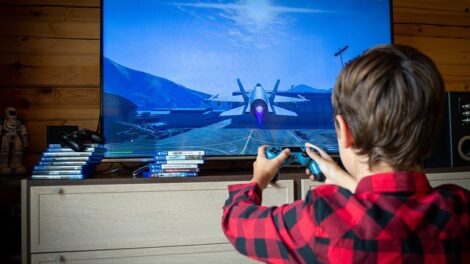A new battle for visual supremacy is unfolding – this time in the virtual dimension. VR pioneers Meta and Apple are both unleashing ultra-immersive spatial video capabilities through their latest headsets, Quest 3 and Vision Pro respectively.
These create the sensation of being dropped right into footage as you glance around in real-time. It’s a startling sensation at first – but once accustomed, prepares to be wowed watching movies, gaming or experiencing events anew through VR’s visual magic.
But which futuristic video viewer ultimately offers the most compelling package? Let’s analyze how Meta’s populist Quest 3 fares against Apple’s premium Vision Pro on critical benchmarks from resolution and content to comfort and accessibility.
Welcome to the Dawn of Spatial Video
Standard video content today displays on a flat, static screen – useful but passive. Spatial video revolutionizes viewing into an active experience by surrounding you with visually immersive footage reacting to your head movements.
Specialized cameras capture live 360 degree scenes or use complex AI to convert traditional video into spatial formats. This lets you lean, duck or glance around elements onscreen as if physically present!
Use cases span thrilling games and adventures, experiencing concerts and events up close, Through augmented workflows even workplace training and virtual tourism open up new dimensions with spatial video’s advent.
Meta Quest 3: The VR Spatial Video Gateway
With Meta Quest 3, the company that sparked mainstream VR interest is now democratizing next-gen spatial video for the masses.
The Quest 3 headset presents media in 3DOF (3 degrees of freedom). This means you can pan your head from side to side, look up and down. But lacking room tracking, you cannot physically move around the virtual environment.
It supports basic and readily available spatial formats like 180, 360 and 3D video. Pair this with Quest 3’s reasonable $399 entry pricing, and VR video immersion lands within reach of most consumers today.
The Content Concession
However, the Quest 3’s spatial video support does come with some caveats…
Viewing sessions are limited to just 20 minutes – likely a battery life concession. And the headset’s older XR2 chipset cannot handle Apple Vision’s more advanced scene reconstruction capabilities.
So those seeking lengthier viewing or the very bleeding edge of immersive video tech may feel left wanting. But Meta democratizes the next evolution of VR video as an appetizer for mass adoption.
Apple Vision Pro: Pushing Spatial Video to the Limit
In signature Apple fashion, their debut VR/AR headset Vision Pro favors proprietary customization over compatibility – for better or worse.
The Vision Pro introduces a new structured light spatial video format leveraging onboard scene reconstruction hardware and algorithms.
This proprietary approach allows visual detail, lighting and reflections to update completely realistically as you shift perspective. The experience aptly earns Apple’s “Reality Pro” branding.
Audio also adapts directionally, increasing the sensation of presence. Even switching between VR and AR viewing based on preference remains possible on the Vision Pro.
You feel less an observer than active participant within impressively rendered scenes. But such trailblazing tech commands an equally pioneering $3000 price tag – likely restricting uptake to creatives and enterprise use cases.
The Closed Ecosystem Catch
Apple wagers heavily that content producers will embrace their new format. But platform exclusivity risks hampering initial spatial video catalogue size.
And the headset itself grapples with weight distribution issues causing neck strain over longer viewing periods. Plus rapid battery depletion challenges continue plaguing most standalone VR devices today.
Still for those seeking the categorical cadillac of immersive video prowess, Apple Vision Pro drives spatial viewing furthest into the future.
Comparing the Key Specs
Breaking down the hardware paints a fuller picture of each headset’s mix of capabilities – and compromises.
| Spec | Meta Quest 3 | Apple Vision Pro |
|---|---|---|
| Resolution (per eye) | 1440 x 1600 pixels | 2448 x 2448 pixels |
| Refresh Rate | 90Hz | 60Hz |
| Tracking | 3DOF (rotation only) | 6DOF (room scaling) |
| Spatial Video Formats | 180, 360 | Proprietary Structured Light |
| Audio | Stereo Spatial Audio | Head Tracked Spatial Audio |
On paper, Apple’s bespoke technological focus enables the most advanced and naturalistic spatial viewing around presently.
But Meta’s conscious compromises still deliver solid immersion at scale – crucial for sparking mainstream spatial video adoption in the years ahead.
Who Takes the Spatial Video Crown?
Evaluating holistically across criteria:
- The Meta Quest 3 rules accessibility and content volume
- While Apple Vision Pro dominates peak visual quality
Ultimately spatial video spreads a feast for the senses no matter your VR headset of choice today.
As barriers to entry keep falling, widespread individual adoption of immersive viewing feels inevitable – be that in gaming, theatrical experiences or educational settings.
And healthy competition between Meta, Apple and inevitable fast followers will spur relentless innovation on both processing power and content quality fronts.
Within just a few generations, bulky headsets could give way to sleek glasses or contact lenses conjuring lifelike holograms right before our eyes.
Buckling up for the spatial rollercoaster already proves well worth it! So which device would you wager on for the most visually mesmerizing ride into the virtual future?










Add Comment